







Cymatics, a Way of Looking at Wave Propagation
The word cymatics (from the Greek kyma, meaning wave) is of fairly recent origin. The technique is not. It was Ernst Chladni who conducted the first experiments and published his findings in 1787 in a book called: Entdeckungen ueber die Theorie des Klanges (Discoveries Concerning the Theory of Music). This and other pioneering works by him laid in effect the foundation for that part of physics that we now call acoustics.
One of his major successes, the one that is relevant here, was to make sound waves visible. He did this by clamping a metal plate, scattering fine sand over the surface and vibrating the plate by drawing a rosined violin bow over the edge.
Depending on the size of the plate, where it was clamped, its composition, thickness and shape and where on the edge the bow was drawn, different patterns emerged in the sand, concentrating the sand on the nodal points where there was no vibration and drawing it away from the vibrating sections.
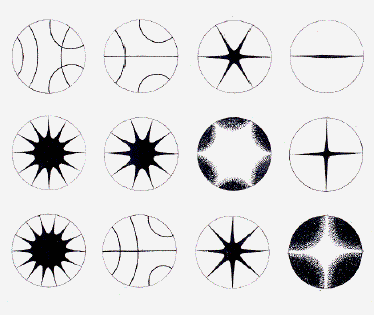
Typical Examples of Chladni Figures
Chladni plates had a distinct disadvantage. They could not be used to analyse different frequencies as the working of the device depended on the frequency of the metal plate which was dependent on its construction. To overcome this restriction a device was created that allowed a wide range of frequencies to become visible on the same apparatus. In Keely's time Rudolf Koenig offered such a device for sale that he called the paper membrane.
The concept was simple. A paper or thin rubber sheet was drawn over a wooden ring, a second ring was drawn over the first trapping the paper or rubber between them and tightened by wooden screws. Similar to a skin on a drum.
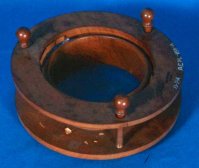
Koenigs Apparatus
It was designed to be used in conjunction with an elliptical bell over which a rosined bow was drawn. Depending on which part of the rim the bow was drawn a number of different sounds could be produced. As before the membrane was covered with a thin layer of fine sand and the emerging patterns studied.
I believe Keely used a similar device to study the effects of a combination of resonators. He talks all the time about nodal points and that was the way to make them visible at the time.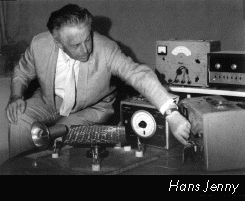 Hans Jenny, the Swiss medical doctor and researcher who coined the term cymatics did little more than to adapt Koenigs membrane to modern technology by using loudspeakers and crystal oscillators instead of resonators. That way he could produce precise wanted frequencies at will. He then photographed and filmed the emerging patterns using the latest photographic techniques.
Some of the photographs and films he produced are stunning. Here is a small selection of photos:
Hans Jenny, the Swiss medical doctor and researcher who coined the term cymatics did little more than to adapt Koenigs membrane to modern technology by using loudspeakers and crystal oscillators instead of resonators. That way he could produce precise wanted frequencies at will. He then photographed and filmed the emerging patterns using the latest photographic techniques.
Some of the photographs and films he produced are stunning. Here is a small selection of photos:
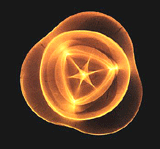
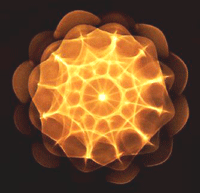
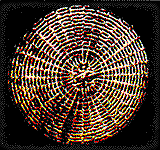 In 1967 he published a book, curiously written as a bilingual volume with the cumbersome title: Kymatik -Wellen und Schwingungen mit ihrer Struktur und Dynamik/ Cymatics - The Structure and Dynamics of Waves and Vibrations.
In spite of the many excellent ad readily repeatable experiments he documents one gets the feeling that his writings and his experiments serve a different agenda.
He cannot help himself to foray into religion with his explanations and elucidations and appears to advocate the idea of "Intelligent Design" only thinly veiled in scientific jargon. The idea of Intelligent Design of course is simply an attempt to make Creationism palatable to a modern society.
The following quotes (in italics) are from an article by Peter Pettersson, translated by Yarrow Cleaves entitled "Cymatics - The Science of the Future?" which is an excellent and accurate précis of Jenny's work and more suitable here than direct passages from his book.
In 1967 he published a book, curiously written as a bilingual volume with the cumbersome title: Kymatik -Wellen und Schwingungen mit ihrer Struktur und Dynamik/ Cymatics - The Structure and Dynamics of Waves and Vibrations.
In spite of the many excellent ad readily repeatable experiments he documents one gets the feeling that his writings and his experiments serve a different agenda.
He cannot help himself to foray into religion with his explanations and elucidations and appears to advocate the idea of "Intelligent Design" only thinly veiled in scientific jargon. The idea of Intelligent Design of course is simply an attempt to make Creationism palatable to a modern society.
The following quotes (in italics) are from an article by Peter Pettersson, translated by Yarrow Cleaves entitled "Cymatics - The Science of the Future?" which is an excellent and accurate précis of Jenny's work and more suitable here than direct passages from his book.
Jenny noticed that when the vowels of the ancient languages of Hebrew and Sanskrit were pronounced, the sand took the shape of the written symbols for these vowels, while our modern languages, on the other hand, did not generate the same result! How is this possible? Did the ancient Hebrews and Indians know this? Is there something to the concept of "sacred language," which both of these are sometimes called? What qualities do these "sacred languages," among which Tibetan, Egyptian and Chinese are often numbered, possess? Do they have the power to influence and transform physical reality, to create things through their inherent power, or, to take a concrete example, through the recitation or singing of sacred texts, to heal a person who has gone "out of tune"?
Trinity
In the closing chapter of the book Cymatics, Jenny sums up these phenomena in a three-part unity. The fundamental and generative power is in the vibration which, with its periodicity, sustains phenomena with its two poles. At one pole we have form, the figurative pattern. At the other is motion, the dynamic process.
These three fields - vibration and periodicity as the ground field, and form and motion as the two poles - constitute an indivisible whole, Jenny says, even though one can dominate sometimes.
Be that as it may he nevertheless describes some interesting phenomena. One experiment in particular stands out.
An interesting phenomenon appeared when he took a vibrating plate covered with liquid and tilted it.The liquid did not yield to gravitational influence and run off the vibrating plate but stayed on and went on constructing new shapes as though nothing had happened. If, however, the oscillation was then turned off, the liquid began to run, but if he was really fast and got the vibrations going again, he could get the liquid back in place on the plate. According to Jenny, this was an example of an antigravitational effect created by vibrations.
This is in effect something that Keely talks about when he tells us that gravity can be influenced by sonic vibrations.
It is a pity that the good doctor did not investigate complex sounds such as chords. This is an area I feel that needs looking into.
I will include in the experimenters section the design of some simple devices capable of demonstrating these phenomena for those that wish to look into the matter further.
NOTE:
An interesting observation is described by a cymatics experimenter on one of the cymatics websites. Unfortunately he does not give his name. (highlighting is mine):
If the piezo transducer is driven at very high, or ultrasonic frequencies, and with a large amplitude it is possible to 'atomize' liquids such as water. This creates a fine mist that resembles steam in appearance. Such mists are actually tiny droplets suspended in the air yet they behave as if they were all part of a single dense fluid medium.
Is this a precondition that has to be created to achieve the dissociation of water?
Next Chapter:
WHERE DO WE GO FROM HERE
Contact:
Hans von Lieven, copyright
2007




















